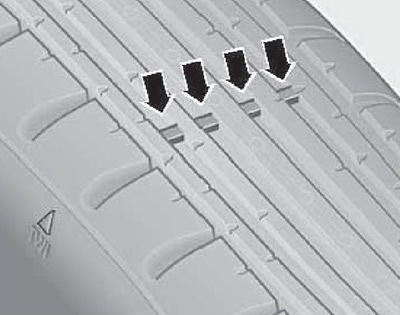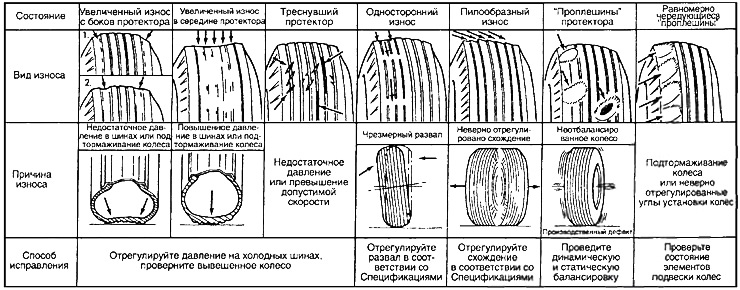Note: Tires and rims suitable for use on the vehicle, as well as tire inflation pressure, are indicated on a sticker located on the B-pillar on the driver's side.
1. With a sporty driving style, it is recommended to increase the tire pressure by 0.3 atm, based on the base value for various load conditions.
2. Winter tires, as a rule, have a pressure of 0.2 atm higher than summer tires. You should take into account the recommendations of winter tire manufacturers, and also remember that such tires have a speed limit.
3. Regularly checking the condition of your tires will help you avoid the hassle of stopping on the road due to a flat tire. In addition, such checks provide valuable information about possible problems with the steering and suspension before serious damage appears in them.
4. The tires used on the vehicles in question are equipped with integrated tread wear indicator strips "TWI" (see resist. illustration), which are exposed when the tread depth is reduced to 1.6 mm. When the tire indicator appears, the tires are considered worn. In most cases, it is recommended to replace tires with a tread depth of less than 2 mm. Winter tires should be changed when the tread depth is less than 4 mm.

12.4 Tire wear indicators
5. Pay attention to any unusual wear on the treads. Tread defects such as caverns, bulges, flattening and more severe wear on one side indicate misalignment of the wheels and/or wheel balance (see resist. illustration). If any of the listed defects are detected, you should contact the tire shop to eliminate them.
12.5 Examples and possible causes of tire wear

6. Carefully inspect the tires for cuts, stuck nails, etc. Sometimes, after a tire is punctured with a nail, it holds pressure for some time or descends very slowly. If there is a suspicion that such "slow puncture" first check the serviceability of the wheel inflation nipple. Then inspect the tread for the presence of stuck foreign objects in it or previously eliminated punctures that have begun to let air through again. You can verify the presence of a puncture by wetting the suspected area with soapy water. If there is a puncture, the solution will begin to bubble. If the puncture is not too big, the tire can be repaired at any tire shop.
7. Carefully inspect the inner side surfaces of the tires for signs of brake fluid leakage, if any, check the brake system immediately.
8. Maintaining the correct tire pressure increases tire life, helps save fuel and improves overall driving comfort. A pressure gauge is required to check the pressure.
9. Always check the pressure on cold tires (those. before driving). If you check the pressure on warm or warm tires, this will lead to an overestimation of the pressure gauge due to thermal expansion of the tires. In this case, do not release the pressure, because. after the tire cools down, it will be below normal.
10. To check the inflation pressure of the tire, remove the protective cap from the nipple, then firmly press the pressure gauge nozzle to the inflation valve and read the reading of the device - it must comply with the requirements of the Specifications. Be sure to replace the protective cap to prevent dirt and moisture from entering the nipple. Check the pressure in all tires, including the spare tire, and inflate them if necessary.
11. In case of severe wear of the front wheels, it is recommended to swap them with the rear wheels. In addition, to ensure even wear, the front wheels should be changed with the rear (without changing between left and right sides) every 5-10 thousand kilometers.
12. Along with checking the tires, check the expiration date of the sealant included in the tire repair kit (if available, see Introduction) and, if necessary, replace it.
